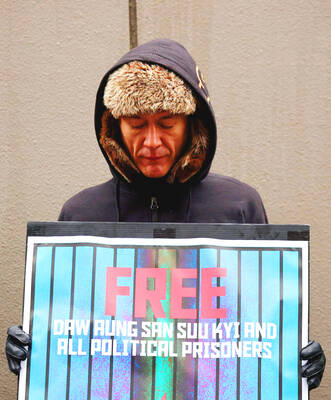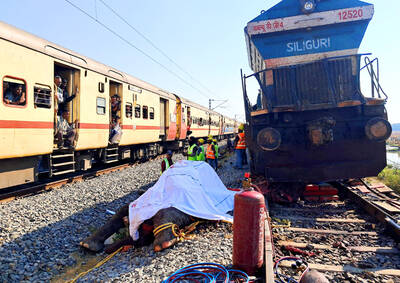Residents of the city's most devastated neighborhoods responded with anger on Wednesday after the city's rebuilding commission unveiled its most contentious proposal: giving neighborhoods in low-lying parts of the city from four months to a year to prove they should not be bulldozed.
The plan was presented at a standing-room-only meeting punctuated by catcalls and angry outbursts that often interrupted members of the panel.
"Over my dead body," was uttered more than once.
"I'm going to suit up like I'm going to Iraq and fight this," said Harvey Bender, a laid-off city worker, who shouted out his comments before an audience at the Sheraton Hotel that numbered in the hundreds and spilled into the aisles and hallways.
Bender owns a home in New Orleans East, a predominantly black middle-class neighborhood of 90,000 residents largely destroyed by the flooding after Hurricane Katrina.
Portions of the neighborhood might not survive, according to the plan, if they do not attract enough returning residents.
Speaker after speaker, black and white, prosperous and poor, dismissed a plan that Mayor Ray Nagin described as "controversial." But Nagin gave them hope as he walked a middle line that neither endorsed the plan nor opposed it.
"This is only a recommendation," Nagin said in remarks that preceded the formal presentation of the rebuilding plan.
"We as a community will have the ultimate say in how we move forward," Nagin said.
The mayor called on people to listen to the commission's presentation with an open mind.
"Take the time to digest this information, to look it over very carefully," Nagin said. "The reality is we will have limited resources to redevelop our city."
Yet the audience did not seem in the mood for calm debate.
"Please let us build our own homes," said Charles Young, a homeowner in Lakeview, a largely white, middle-class neighborhood. "Let us come back on our own time. Let us spend our insurance money, which we paid for on our own."
Under the proposal, residents would not be allowed to move back into the hardest-hit neighborhoods -- about two-thirds of the city, including more than half its home-owners -- for at least four months. During that time, the leaders of each neighborhood would have to submit to a city-wide planning body a recovery plan that would have to be approved before residents would be allowed back.
Neighborhoods not able to formulate an acceptable plan, or those that do not attract sufficient development within a year, could be bulldozed and returned to marshland, with the city compensating homeowners.
The plan represents a compromise between the homeowners in low-lying areas who are determined to rebuild, and the scientists and other experts who believe the city should allow large portions of its flood-prone areas to revert to marshland.
Each neighborhood would have at its disposal teams of planners and other experts to help residents do what they need to prevent the city from forcing them to live elsewhere.
"We want to give every community as best a chance to come back as we can," said Joseph Canizaro, a member of the commission.
Much of the crowd's enmity was directed at Canizaro, the plan's main author and a prominent developer here, who was booed several times.
"Joe Canizaro, I don't know you, but I hate you," said Bender, the New Orleans East resident, when granted his turn at the microphone.
Robyn Braggs, another resident of New Orleans East, said, "I don't think four or five months is close to enough time given all we would need to do."
Because former residents are scattered around the country, she said, many, especially those with school-age children, "won't be able to even return to do the work necessary until this summer."
Marc Morial, a former mayor of New Orleans and current president of the National Urban League, described the commission's proposal as a "massive red-lining plan wrapped around a giant land grab."
Many homeowners will not be able to settle with their insurance companies if they do not know the future of their neighborhoods, he said.
"It's cruel to bar people from rebuilding," Morial said. "Telling people they can't rebuild for four months is tantamount to saying they can't ever come back. It's telling people who have lost almost everything that we're going to take the last vestige of what they own."
Not everyone opposed the plan. One resident of Eastover, a wealthy, largely black community in the eastern part of the city devastated by the storm, said he accepted the commissioners' challenge.

The Burmese junta has said that detained former leader Aung San Suu Kyi is “in good health,” a day after her son said he has received little information about the 80-year-old’s condition and fears she could die without him knowing. In an interview in Tokyo earlier this week, Kim Aris said he had not heard from his mother in years and believes she is being held incommunicado in the capital, Naypyidaw. Aung San Suu Kyi, a Nobel Peace Prize laureate, was detained after a 2021 military coup that ousted her elected civilian government and sparked a civil war. She is serving a

REVENGE: Trump said he had the support of the Syrian government for the strikes, which took place in response to an Islamic State attack on US soldiers last week The US launched large-scale airstrikes on more than 70 targets across Syria, the Pentagon said on Friday, fulfilling US President Donald Trump’s vow to strike back after the killing of two US soldiers. “This is not the beginning of a war — it is a declaration of vengeance,” US Secretary of Defense Pete Hegseth wrote on social media. “Today, we hunted and we killed our enemies. Lots of them. And we will continue.” The US Central Command said that fighter jets, attack helicopters and artillery targeted ISIS infrastructure and weapon sites. “All terrorists who are evil enough to attack Americans are hereby warned

Seven wild Asiatic elephants were killed and a calf was injured when a high-speed passenger train collided with a herd crossing the tracks in India’s northeastern state of Assam early yesterday, local authorities said. The train driver spotted the herd of about 100 elephants and used the emergency brakes, but the train still hit some of the animals, Indian Railways spokesman Kapinjal Kishore Sharma told reporters. Five train coaches and the engine derailed following the impact, but there were no human casualties, Sharma said. Veterinarians carried out autopsies on the dead elephants, which were to be buried later in the day. The accident site

‘EAST SHIELD’: State-run Belma said it would produce up to 6 million mines to lay along Poland’s 800km eastern border, and sell excess to nations bordering Russia and Belarus Poland has decided to start producing anti-personnel mines for the first time since the Cold War, and plans to deploy them along its eastern border and might export them to Ukraine, the deputy defense minister said. Joining a broader regional shift that has seen almost all European countries bordering Russia, with the exception of Norway, announce plans to quit the global treaty banning such weapons, Poland wants to use anti-personnel mines to beef up its borders with Belarus and Russia. “We are interested in large quantities as soon as possible,” Deputy Minister of National Defense Pawel Zalewski said. The mines would be part